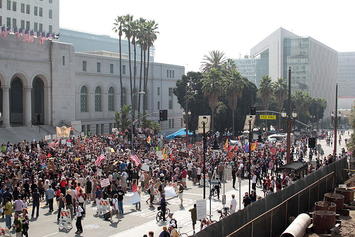
Perhaps nothing so animates the progressive Left today as the notion of an increasingly race-conscious society, segregated by ethnic identity and dismissive of the traditional ideal of assimilation. If this seems ironic, it should—in the not-so-distant past, this was a position embraced by the reactionary Right, particularly in the Jim Crow South. Today, however, progressives support separate dorms for African-Americans and promote restricted “safe spaces” for minorities and other designated victim groups. Indeed, it’s hard to pick up the New York Times—even its arts, sports, or travel pages—without seeing race-based analysis and reportage. The Times’s racial obsession reached new intensity with the “1619 Project,” which overstates the role of slavery in American history and economic development.
This newly energized racial consciousness asserts that most white Americans are racist, even as roughly three in four Americans—including whites, Republicans, and independents—regard racial diversity as “very good” for the country. The proportion of Asian, African-American, and Hispanic college graduates has increased since 2000, even as the share of whites has dropped. As Coleman Hughes has observed, the incarceration rate for African-Americans, though much higher than those of other ethnic groups, dropped by 34 percent between 2001 and 2017—and more so among the young.
Despite these positive trends, American perceptions of racial amity have steadily worsened since Barack Obama’s second term in the White House. President Donald Trump and his sometimes-inflammatory tweets have contributed to this trend, but much blame also belongs to progressives’ racialist agenda. At one time, liberals saw integration and assimilation as critical to achieving a just society. Now, they too often embrace a worldview that defines individuals by race. Racialist intellectuals such as Ibram X. Kendi, author of How to Be an Antiracist, dismiss the notion of “color blindness,” insisting that any divergence in outcomes between groups reflects racist design.
Legal classification of people by their ethnonational background has a long history in Europe and Asia, though not necessarily to the long-term benefit of minority groups. Under the Ottoman millet system, for example, individual communities—Jewish, Christian, and Muslim—controlled their own internal affairs; not being forced to live together as a common culture, they could not, once that system broke down, find ways to live with diversity. Similarly, the Soviet system allowed each “minority” its own homeland, where local party bosses could hand out favors and rule their subjects in their native tongues. When the USSR collapsed, the newly liberated ethnic states were soon at one another’s throats.
Today, we’re witnessing what one scholar has called “the racialization of American politics and society.” Race, sadly, now separates the political parties more than ever. Democratic Party support is 40 percent nonwhite, while the GOP’s is 90 percent white. With America poised to become majority-minority as early as 2045, many left-wing pundits assume that the racial calculus will pay rich political dividends. But America’s nonwhite destiny isn’t as imminent as it appears. As demographer Wendell Cox notes, Hispanics, long viewed as the guarantor of Democratic dominance, are experiencing the sharpest decline in fertility rates of any ethnic group. Immigration from Mexico has plummeted, a trend that started under President Obama, with more Mexican immigrants now leaving than arriving in the U.S. The fertility rate of Asians, the fastest-growing immigrant group, is lower than that of non-Hispanic whites.
And then there’s what journalist Sergio Munoz has called “the multiculturalism of the streets.” Even as the media and political class demand that people identify with their race, everyday life suggests an erosion of racial categories. Nothing illustrates this more than the rise in racial intermarriage, which has soared from barely 5 percent in 1980 to 17 percent today. Such shifts reflect seismic attitudinal changes. The percentage of non-black Americans opposing marriage to an African-American, notes Pew, has dropped from 63 percent in 1990 to 14 percent today. The America of 2050 likely will not be the collection of separate ethnic communities allied against white supremacy, as envisioned by “woke” progressives; it will resemble more closely what Walt Whitman called “a race of races,” with more of the population having two or more ethnic identities.
Progressives assume that policies designed to help certain racial groups automatically benefit them, yet racial identity and economic empowerment are not the same thing....
Read the rest of the piece at City Journal.
Joel Kotkin is the Presidential Fellow in Urban Futures at Chapman University and Executive Director for the Center for Opportunity Urbanism. His last book was The Human City: Urbanism for the Rest of Us (Agate, 2017). His next book, The Coming of Neo-Feudalism: A Warning to the Global Middle Class, is now available to preorder. You can follow him on Twitter @joelkotkin
Photo credit: Mikey Wally via Wikimedia under CC 2.0 License.












